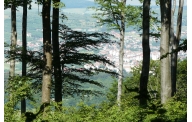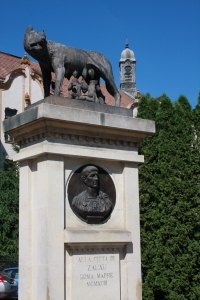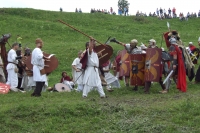
About Zalău
Placed in the North-Western part of Romania, capital city of Sălaj County, Zalău covers a total area of 9009 ha. It is composed by the city of Zalău and the village Stîna, located nearby. A section of the administrative territory of Zalău is taken by Meşes Mountains, which contributes essentially to the quality of the environment. 3003,60 ha out of 9009,00 ha are forests, approximately 3044 ha are agriculture fields.
The archeological research prove the existence of human settlements on the territory of Zalău going back 6500 years, namely from the Neolithic period. The continuity of the human activity in this area is certified by the artifacts discovered in the archeological sites (coins, axes, ceramics etc).
As for antiquity period, it is important to bear in mind that after the emperor Trajan had conquered Dacia (106 AD), the border of the Roman Empire passed on the peaks of Meseş Mountains. The territory north from it belonged to free Dacians. In the Eastern - South Eastern part, the roman build a defense system with fortifications, towers, entrenchments, and ditches ("limes porolissensis"). On Zalău territory, several traces of wooden Roman castrums have been discovered. At Porolissum (on the territories of Moigrad and Jac villages) can be seen even today remains of the Roman Castrum, civil settlements and the stone road connecting other surrounding locations.
The first written notice about Zalău is mentioned in "Gesta Hungarorum" also called the Anonymus Chronicle, around year 1210. Anonymus was the notary of King Bela the IVth of Hungary.
After tartar invasion and the city devastation from 1241, Zalău had been run by the Catholic Bishopric of Oradea since 1246 until 1542. That year the settlement was included into the Transylvanian Princedom. On the first of August 1473, Matthias Corvinus, king of Hungary and Bohemia, declared Zalău "Oppidum Zilah" (fair-town, borough). This privilege gave the settlement the right of free commerce and economic independence. The main economic advantage was conferred by the geographical position. Zalau was on the main access road to Transylvania ("salt way").
At the end of the XVIth century, the town still belonged to Transylvania Princedom and it enjoyed an autonomous administration of 33 elected senators. Among them one was elected mayor.
Another important moment in Zalăus history is when the Romanian ruler Mihai Vitezu camped his army in the northern part of the city, just before he defeated Sigismund Bathory (the Prince of Transylvania) at Guruslău (20 km away).
A chronic from the XVIIth century noticed for the first time the crafts of the local citizens. They were: belt makers, potters, wheelers, shoemakers, butchers, blacksmiths, carpenters, hat makers, armourers.
Throughout the XVIth and XVIIth centuries, in Transylvania o number of reformed colleges were established. In 1646 the first college was set in Zalău, in one of the 3 buildings where today the "Silvania" National College functions..
The town begins losing its importance once new ways to Transylvania had been discovered. From the economic point of view, craftsmanship is still the main occupation, but also viticulture, fruit growing (Zalău exported fruits in the first part of the XXth century).
In 1968 Zalău becomes the capital of Sălaj County, and in 1979 is declared municipality (municipiu).
Throughout the history, the place was given various names: "Zilah" in 1220, "Oppidum Zilah" in 1473, "Zila" in 1601, Szilaj - Sszilagy in 1839, Szilaju in 1850 and Zilah - Walthenberg - Zălau in 1854.
To visit
1. The City Hall of Zalău
The building that today houses the City Hall of Zalau was finished in 1889 and was meant for hosting the Prefecture, the Courthouse and the Prosecution Office of Sălaj County. The edifice, built in baroque style, has a trapesoidal plan with an inner yard with three entrances. The most attractive feature is „Avram Iancu" Hall, with its massive chandelier that weights 1450 kg and is made by wrought iron; the hall was used in the past for dance and other festive meetings. The wedding ceremonial hall is another attractive space.
Address: 3 Iuliu Maniu Sq.
2. "Silvania" National College
Throughout the sixteenth and seventeenth centuries o number of Calvinist colleges had been established in Transylvania. The one in Zalău was set in 1646. The Reformed College in Zalău functioned as a secondary school. During 1800-1862, the college infrastructure was extended with two other buildings, to its present form. In the beginning, the Latin was the teaching language, and then changed to Hungarian language. Iuliu Maniu (the prime minister of Romania during 1928-1933), Ady Endre (a famous Hungarian poet), Biro Lajos (zoologist and biologist) and Victor Deleu (former secretary general of the Home Affair Minister, former mayor of Cluj Napoca in the early of 30) graduated from "Silvania" National College.
Address: 1 Iuliu Maniu Sq
3. Transylvania Building
The main historical building of Zalau is compound of three segments located in the Soutern part of Iuliu Maniu Square, in the center of teh city. The construction of this edifice started in the middle of the nineteenth century. Based on pictures one can mention that the construction was finished in 1901. During the last century, diverse activities were carried on in Transylvania building, like: restaurant, cafe, small hotel, appartments for public servants, a dance and a theatre hall („Carol" Theatre House). The theatre hall has a surface of 350 sqm and additional rooms. The Hall was used for other public purposes: different meetings, ceremonies and parties on New Years Eve. The ceiling of the Hall is decorated with a painting in oil from the twentieth century which is the most valuable decoration of the building. In front of the edifice, Wesselleny monument was eraised in 1902; the monument is the work of the Hungarian artist Janos Fadrusz. In present, the construction is being rehabilitated. The works will be finalised in the end of 2013 and it will be open to visitors.
Address: 5 - 7 Iuliu Maniu Sq
4. The County Museum of History and Art
The building was constructed in the first years of the XXth century. In the beginning it housed the casino of the handicraftmen and then a college for boys. The first exhibition opened in 1926. Presently, the County Museum of History and Art hosts over 50,000 archeological, historical, etnographical artifacts and pieces of contemporary fine arts.
Address: 9 Unirii St
5. „Ioan Sima" Art Musem
Created in 1951, the Art Musem owes its name and reputation to the painter Ioan Sima from Sălaj. He donated about 200 paintings and personal bellongings to be preserved in a proper space and to represent the core of a memorial museum. Besides these pieces, the Museum owns works of other important Romanian artists: Corneliu Baba, Aurel Ciupe, Rudolf Schwitzer Cumpăna, Petre Abrudan, Alexandru Mohi, Paul Sima, Ioan Mitrea. The butterfly and bugs collection gathered from all over the world is another attraction for the public.
Address: 6 Gheorghe Doja St.
6. „Sfânta Vineri" Cultural and Religious Complex
It is a complex edifice of modern architecture with three components: the Bishopry Cathedral named „Inălţarea Domnului" (the Ascension) with a capacity of 5000 places, an obelisk dedicated to heroes of 50 m hight and a museum. The plan of the church is a replica in a smaller size of Saint Sophia Cathedral in Istambul. The museum hosts ancient books, icons painted in glass, wooden icons and other pieces of historical, artistic and reference values. The immense and genuine chandelier, made of bronze, weights 2000 kg, it is 7 m height and includ 360 electric bulbs.
Address: 20 Sfânta Vineri St
7. „Adormirea Maicii Domnului" Church (The Assumption Cathedral)
Located in the central area, it was build during 1930 - 1932, with the financial suport of individuals and the state. Iulia Maniu, prime minister at that time, had a great contribution to support the project. The sanctification of the church took place in 1934. Today, it belongs to the Orthodox Church. An important event in the Churchs life represents the annual ceremony of the Assumption (15 august), even those from the neighbouring villages are attending the religious service.
Address: 12 1 Decembrie 1918 Sq.
8. „The Holy Trinity" Roman Catholic Church
The church construction started in 1878. The consecreation was held in 1884. The old bells were confiscated in 1917, the only one left being the one casted in the honour of St. John in 1911. In 1929 other two belles were donated to the church. One is dedicated to the Holy Trimity and the Holy Virgin Maria, whiloe the smallest one is dedicated to St. Joseph.
Address: 6 Mihai Viteazu Blvd.
9.The Reformed Church
Erected in 1712 on the remains of an ancient church, it was several times expanded and rehabilitated. Presently, it is an imposing construction located in the central area of the city, on a hill. Grace to its size (1600 seats), it is the second in rank among the reformed churches in the Eastern parte of the Central Europe. The Church has held a pipe organ since 1906 and concerts are organised occasionally. The horologe dates back from the beginning of the twentieh century and is still functioning.
Address: 7 Andrei Şaguna St.
Meseş Mountains
They are a segment of the Western Carpathians Mountains, the highest peak being Măgura Priei (996 m). Zalău Municipality owns 1550,74 ha of forests that hide the old Roman trail, walls and towers surrounding the Roman Castrum Porolissum. In the woods, a variety of forest species are found like: beech, holm, hornbeam, pine spruce, pine, black pine, aspen. In spring, glades of snowdrops are decorating the nature, pleasing those fond of backpacking and walking in fresh air.
The fauna is diverse; while wandering the walking paths one can encounter a deer, roebuck, hare, pheasant, francolin, large duck, fox and wild boar, wolf, linx. The forestry road network have a lenght of 16,5 km and the marked touristic paths complete the access infrastructure.










.jpg)
















 Subscribe via RSS
Subscribe via RSS

